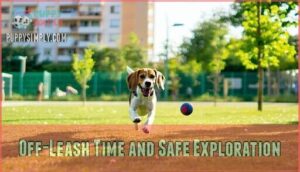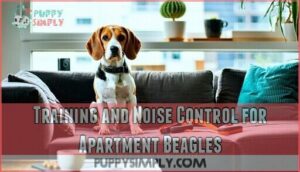This site is supported by our readers. We may earn a commission, at no cost to you, if you purchase through links.

These compact hounds were bred to work tirelessly alongside hunting packs, which means their requirements go far beyond a simple food bowl and soft bed. When you match their exercise demands with consistent training and mental challenges, even a studio apartment can become home.
The key lies in working with their natural instincts rather than against them, transforming potential obstacles into manageable routines that fit your lifestyle.
Table Of Contents
- Key Takeaways
- Can Beagles Thrive in Apartments?
- Beagle Temperament and Behavior in Small Spaces
- Meeting Beagle Exercise and Mental Needs
- Training and Noise Control for Apartment Beagles
- Health and Wellness for Apartment Beagles
- Frequently Asked Questions (FAQs)
- How do I introduce my Beagle to my other pets in the apartment?
- What grooming needs do apartment Beagles have?
- How much does owning an apartment Beagle cost?
- Are Beagles good with apartment children or pets?
- Whats the best diet for apartment-dwelling Beagles?
- Can Beagles handle being alone in apartments daily?
- Conclusion
Key Takeaways
- Beagles can thrive in apartments if you meet their substantial exercise needs (60-90 minutes daily) and provide consistent mental stimulation, proving that success depends on your commitment to their routine rather than square footage alone.
- Managing their signature baying and scent-driven behaviors through early training, the "quiet" command, and puzzle toys is essential for maintaining harmony with neighbors and preventing destructive habits in confined spaces.
- Weight management becomes critical in apartment settings since Beagles carry a genetic predisposition toward obesity, requiring controlled portions and structured fitness plans to counteract limited space for natural movement.
- Health vigilance matters more in apartments due to increased risks of ear infections (14.72% annual risk from their floppy ears) and epilepsy onset between six months and three years, making biannual vet checkups non-negotiable.
Can Beagles Thrive in Apartments?
Can Beagles thrive in apartments? It comes down to three things: your space, your daily routine, and how you get along with the neighbors.
Here’s what actually matters.
Beagle Size and Space Requirements
Beagles stand 13 to 15 inches tall and weigh 20 to 30 pounds at maturity, making them manageable apartment dogs. However, their compact size doesn’t tell the full story. You’ll need at least 9.5 square feet of floor space for your beagle’s primary area, though this doubles without adequate daily exercise.
Many beagles thrive in smaller apartments when their physical and mental needs are met through consistent outdoor activity. To maintain a healthy weight, it’s vital to monitor their beagle weight and provide regular exercise.
Apartment Layout and Adaptations
Your beagle’s apartment doesn’t need a complete overhaul, but a few smart tweaks can make all the difference between a restless dog and a content companion. Start with furniture arrangement that creates clear pathways for your dog to move freely—think space optimization rather than cramming every corner.
Vertical exploration matters too; cat trees or low shelves give curious beagles safe ways to survey their territory. If you’ve got a balcony, secure it properly and use it for supervised sniff sessions.
Storage solutions keep shoes and tempting items out of reach, preventing destructive chewing in your small space living setup.
Socialization and Neighbor Relations
Once you’ve arranged your space to work with your beagle’s needs, building trust with the people who share your building becomes the next step in apartment harmony. Here’s how to master neighbor interactions and community building:
- Introduce your beagle early – Let neighbors meet your dog before noise issues arise, creating goodwill that smooths future conflict resolution.
- Practice apartment etiquette with consistent noise management – Address barking immediately through dog behavior management** and training.
- Share contact information – Give neighbors your number for noise control concerns, showing you’re committed to respectful apartment living.
Beagle Temperament and Behavior in Small Spaces
Your beagle’s natural temperament shapes everything about apartment living—get to know it first, and you’ll save yourself a lot of headaches.
Beagles pack personality quirks that either click perfectly with apartment life—or clash hard if you haven’t thought things through.
Three parts of their behavior matter most for your day-to-day.
Energy Level and Activity Needs
Think of Beagles as marathon runners—they’re built for endurance, not couch-sitting. Adult Beagles need 60 to 90 minutes of daily exercise to stay healthy and prevent behavioral issues in apartment living. Without proper physical stimulation, you’ll notice restlessness, destructive chewing, and excessive barking.
Plan two 30-minute walks plus play strategies like fetch or tug-of-war. Puppies under 12 months show the highest activity patterns, while seniors over eight still benefit from consistent exercise needs for muscle and cardiac health. Beagles require regular daily exercise routines to maintain their physical and mental well-being.
Affection and Bonding With Owners
Your Beagle’s loyalty isn’t just a trait—it’s the foundation of apartment life success, turning tight quarters into a cozy haven when that bond runs deep. These hounds form intense owner attachment, thriving on emotional support and canine companionship. Strengthen your family bonds through:
- Daily greeting rituals that make your Beagle’s tail wag uncontrollably
- Designated cuddle time on the couch after walks
- Training sessions that build trust and loyalty training foundations
- Consistent routines that signal you’re their reliable anchor
- Calm departures that ease separation anxiety in apartment living
Focus on that connection, and apartment life with your Beagle shifts from daily struggle to genuine reward.
Managing Scent-Driven Behaviors
When that nose hits the ground, your Beagle’s entire world shifts—and managing this scent-driven obsession can make or break apartment harmony.
Channel this instinct through nose work games and tracking exercises indoors. Olfactory stimulation via scent habituation training—hiding treats around your space—satisfies their hunting drive without destructive behaviors.
Consistent beagle behavior and training prevents counter-surfing and escape attempts, essential skills for successful apartment living with canine behavior challenges.
Meeting Beagle Exercise and Mental Needs
Your Beagle’s happiness in apartment life hinges on meeting their substantial physical and mental needs every single day. These scent hounds weren’t bred to lounge around—they need structured exercise, engaging activities, and safe opportunities to express their natural instincts.
Here’s what your apartment Beagle needs to stay healthy, happy, and on their best behavior.
Daily Walks and Play Sessions
A structured exercise routine is the foundation of apartment living success with your Beagle. Adult Beagles need at least 60 minutes of daily exercise, ideally split into two brisk 30-minute walks.
Here’s what makes an effective routine:
- Morning and evening walks provide consistent energy outlets and prevent boredom-related behaviors
- Brisk pacing matters—leisurely strolls won’t satisfy your Beagle’s high energy needs or exercise requirements
- Sniff breaks during walks support natural scent-driven behaviors while adding mental enrichment
- Play sessions of 10–20 minutes (fetch, tug, or scent games) should supplement walks 2–3 times daily
- Leash training is essential for apartment living—practice before heading outdoors to guarantee safety
Consistent exercise reduces excessive barking and destructive chewing while improving training outcomes.
Mental Stimulation and Puzzle Toys
A bored Beagle with pent-up energy doesn’t just bark—they’ll redesign your apartment, one chewed shoe at a time.
Mental enrichment through puzzle toys and interactive games keeps their scent-hound brain engaged. Rotate treat-dispensing puzzles, snuffle mats, and hide-and-seek games to prevent boredom.
This brain stimulation complements physical exercise and fosters positive dog behavior, making apartment living with pets more manageable while strengthening your bond with your Beagle.
Off-Leash Time and Safe Exploration
Like releasing a tightly wound spring, off-leash time lets your Beagle’s natural instincts unfold in ways a standard walk simply can’t match. Seek safe areas like fenced dog parks or secure yards where your Beagle can enjoy free roaming without escaping.
Master leash training first, then practice recall commands before allowing exploration. Use outdoor boundaries strategically—sniffing trails and exploration techniques satisfy their scent-driven nature while keeping apartment living with pets balanced and your Beagle mentally fulfilled.
Training and Noise Control for Apartment Beagles
Teaching your beagle to thrive in an apartment goes beyond noise control. You’re setting your dog up to feel comfortable and secure when living in tighter spaces.
These three areas will determine whether apartment life works smoothly—or becomes a constant headache. Here’s where to put your energy for a peaceful living situation.
Managing Vocalization and Baying
If you’ve ever heard a Beagle’s signature bay echoing through your apartment walls at 6 a.m., you know that managing their vocal tendencies isn’t just about keeping the peace—it’s essential for harmonious apartment living. Start vocal training early using the "quiet" command paired with consistent positive reinforcement.
Address triggers like boredom or separation anxiety through adequate exercise and mental stimulation, which naturally reduces excessive barking. Puzzle toys and interactive games keep your apartment dog engaged, minimizing noise-driven neighbor relations issues while supporting effective baying control.
Essential Commands for Apartment Living
Beyond keeping your Beagle quiet, teaching core obedience commands transforms tight apartment spaces into environments where both you and your dog can relax without constant stress.
Focus on basic obedience like "sit," "stay," and "come"—these promote apartment etiquette and prevent chaos during hallway encounters.
Pair leash training with the quiet command you’ve already introduced, reinforcing noise control through consistent dog training that respects neighbor relations while building your apartment dog’s confidence and reliability indoors.
Preventing Destructive Behaviors
When commands aren’t enough to keep your Beagle’s natural energy in check, destructive chewing, scratching, and digging become the apartment dweller’s worst nightmare—but you can prevent these behaviors before they start. Boredom prevention starts with solid exercise routines—tire out your Beagle before leaving home. Crate training creates a safe haven and prevents damage, while chew toy management redirects natural urges appropriately. Address separation anxiety early through gradual departures, keeping noise control and neighbor relations intact while supporting healthy Beagle behavior and training.
- Exercise before alone time: A tired Beagle is less likely to destroy your apartment—prioritize morning walks and play sessions
- Rotate chew toys weekly: Keep interest high with variety, preventing boredom-driven destruction of furniture or walls
- Practice crate training gradually: Build positive associations so your Beagle views their crate as comfort, not confinement
- Implement separation anxiety protocols: Start with short absences, reward calm behavior, and avoid dramatic goodbyes that trigger stress
Health and Wellness for Apartment Beagles
How healthy your beagle is will shape their entire apartment experience. Catching problems early—before they become issues—makes apartment living work for both of you.
From maintaining a healthy weight in limited space to preventing common breed-specific problems, you’ll need a proactive approach.
Here are the key health considerations that keep apartment beagles thriving.
Weight Management and Exercise
Beagles carry a genetic predisposition toward obesity, that makes weight management one of your most important responsibilities as an apartment owner. Without consistent daily exercise—ideally those two walks plus interactive play—your Beagle can quickly pack on extra pounds.
A healthy diet paired with an active lifestyle keeps your dog fit, while structured fitness plans help you meet their exercise needs even in smaller spaces.
Common Health Issues (Ear Infections, Epilepsy)
Those long, floppy ears that make your Beagle so adorable also trap moisture and debris, creating the perfect environment for ear infections. Studies show Beagles face a 14.72% annual risk of otitis externa—nearly double that of dogs with upright ears. Watch for head shaking, scratching, or unusual odor.
Epilepsy also affects Beagles more than many breeds, with seizure onset usually occurring between six months and three years of age.
Veterinary Care and Preventative Measures
Regular vet visits are essential, not optional. They catch health problems early—problems that can sneak up on Beagles living in apartments.
Schedule health checkups every six months to monitor weight, dental care needs, and early disease signs. Your vet will customize vaccination schedules, parasite control protocols, and nutrition planning based on your dog’s lifestyle.
This proactive approach to canine health promotes animal welfare and keeps your Beagle thriving in compact spaces.
Cleanliness and Apartment Safety
Your apartment’s cleanliness standards directly impact your Beagle’s respiratory health and your landlord’s willingness to renew your lease.
Vacuum floors twice weekly to control shedding and protect flooring from scratches. Address pet waste immediately and use enzyme cleaners for odor control.
Establish mess prevention routines—like paw-wiping stations at entryways—to maintain apartment sanitation while keeping your apartment dog happy and your living space spotless.
Frequently Asked Questions (FAQs)
How do I introduce my Beagle to my other pets in the apartment?
Gradual introductions work best for Multi Pet Households—start with scent swapping through closed doors, then progress to brief supervised meetings in neutral spaces.
Patience and positive reinforcement help establish Apartment Pet Harmony across species.
What grooming needs do apartment Beagles have?
Weekly brushing keeps your Beagle’s short coat healthy and minimizes shedding in tight apartment spaces.
You’ll also need regular nail trims, ear cleaning to prevent infections, and occasional baths for skin health and odor control.
How much does owning an apartment Beagle cost?
Owning a Beagle in an apartment generally costs $1,000–$2,500 annually. Food expenses, veterinary bills, supply costs, insurance fees, and maintenance budgets vary based on your dog’s health and lifestyle needs.
Are Beagles good with apartment children or pets?
Yes, Beagles excel with children and pets when proper Beagle Socialization occurs early. Their gentle nature fosters Family Dynamics and Pet Harmony. Child Safety improves through supervised interactions.
Apartment Dogs like Beagles thrive with consistent Dog Care and Training, following Coexistence Tips for peaceful Raising Beagles in Apartments environments.
Whats the best diet for apartment-dwelling Beagles?
Quality protein sources paired with controlled portions form the foundation of balanced nutrition for your Beagle.
Watch for food allergies and consider nutrient supplements if needed, though homemade diets require veterinary guidance to guarantee complete animal health and wellness.
Can Beagles handle being alone in apartments daily?
Most Beagles struggle with extended alone time due to their pack-oriented nature. Separation Anxiety is common in apartment settings without gradual conditioning.
Daily Routine Planning, interactive toys for Solo Activity Ideas, and Apartment Safety Measures help Apartment Dogs adapt to solitary hours successfully.
Conclusion
Living with a Beagle in an apartment takes work—there’s no getting around it. If you’re reading can beagles live in apartments a complete guide or already dealing with the day-to-day reality, here’s what matters: honor their hunting instincts while making it work in your space.
Keep them exercised, train away the barking, stay on top of their health. The payoff? A faithful companion who shows you that a great home isn’t about how much room you have.
Handle their exercise needs, train them to manage the barking, and stay consistent with vet visits. What you get back goes beyond a dog who behaves—you get a companion who reminds you that a good home isn’t about the square footage.
A good home isn’t measured in square footage—it’s built through exercise, training, and the bond you create with your companion
- https://timesofindia.indiatimes.com/life-style/relationships/pets/labrador-vs-beagle-which-is-the-best-dog-for-apartment-living/photostory/121570436.cms
- https://www.beaglepro.com/beagle-apartment-dog
- https://www.shelteranimalscount.org/17-best-dog-breeds-for-seniors/
- https://www.multifamilydive.com/news/dogs-and-cats-are-priority-no-1-for-potential-renters/715772/
- https://www.dogster.com/lifestyle/how-much-exercise-does-a-beagle-need












